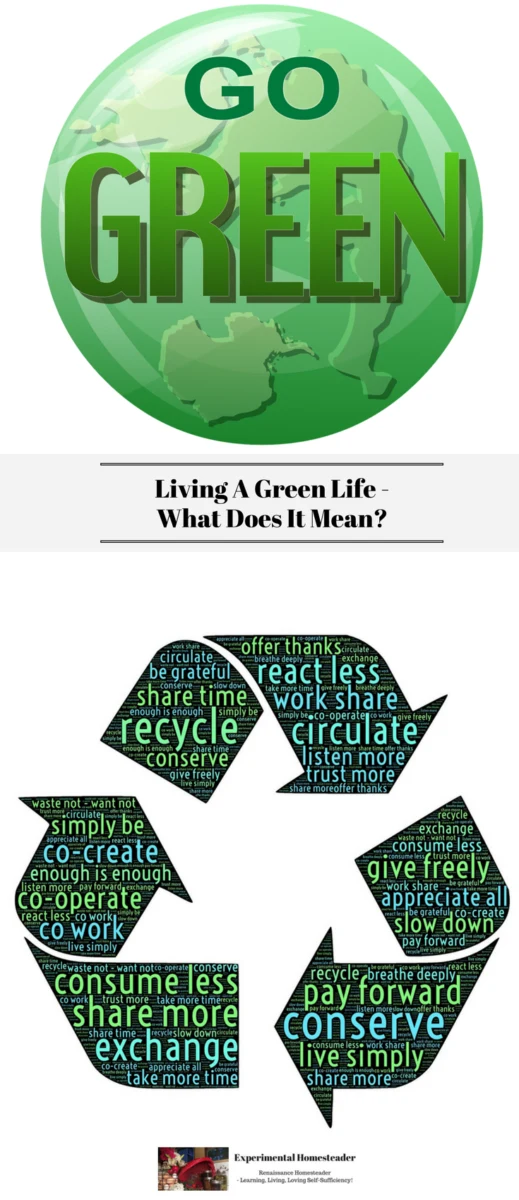Recently, you may have been hearing a lot of buzzwords such as "green" or "sustainable" living, but what does living a green life really mean?
There are also links below to products I recommend from companies I have a referral relationship with. I will be compensated if you make a purchase after clicking on my links.
Sustainable Living Or Green Living - Which Is Better?
Sustainable living and green living are interchangeable concepts, which both mean living a lifestyle that does not harm the environment but encourages its health and stability.
For the last few hundred years, mankind has been living unsustainably, simply meaning that we are using the earth's resources faster than the earth can produce them, and many of these resources won't come back once they've been used up.
Due to this, we are creating a world where nature is being thrown sharply out of balance.
This means disaster for the entire planet.
Fortunately, we can turn things around by changing our habits.
One of which is changing our lifestyle from one of constant consumption to one that is more conscientious about the safety and health of the environment.
Sustainable Living: A Definition
Sustainable living refers a lifestyle that strives to reduce one's carbon footprint.
This simply means living in such a way that preserves instead of consumes the earth's natural resources, as well as preserves their own personal resources.
The point of sustainable living is breaking the cycle of overconsumption seen throughout the world - and this is why is it sometimes referred to as a green lifestyle.
So many people consume whatever they want until nothing is left.
They should be learning to conserve their resources in order to make them last longer as well as share them with others including future generations.
There Are Some Extremes
Sometimes individuals who take things a little far - and this is what many people think green living requires because they hear about it or read about it in the news.
Some examples of going too extreme include urinating in a jar to preserve water in the toilet, reducing showers to once or twice a month, or shutting off the power despite the needs of the house or family without having solar or wind backup to generate electricity.
While this may work for some individuals, for most, it can make life unnecessarily difficult.
With this in mind, it is important to remember that moderation is a good rule of thumb.
Living sustainably can be done by making small changes to your everyday life that will benefit the environment and perhaps change your lifestyle for the better.
How To Get Into The Green Living Mindset
One of the best ways to get into a mindset of living sustainably is to remember that nothing is set in stone.
We often use things quickly without regard to preservation because we know we can always get more.
If we run out of crackers, we can run to the store and get more.
If we are running low on lotion, there is a market just down the street.
Need food?
There are plenty of restaurants all over.
While this is technically true, it does not mean that these things will always be there.
Things can change, and problems can arise, making it important to prepare for the unforeseen by living smart.
Preserve food, don't overuse water and power, and consume in moderation.
It is the best way to live for both you and the environment.
Great Ways To Live A Green Life
Try these simple lifestyle changes to integrate "green" living habits into your everyday routine.
-
Organic Eating:
One of the easiest changes you can make is to switch to organic foods. By helping sustain organic markets and farms, you are helping reduce the use of chemicals in our food and soil. Some say that organic eating can be expensive, and while this can be true, it doesn't have to be. You can shop at local farmers markets as well as do your own farming. Many people have taken to creating their own fruit and vegetable gardens as well as housing chickens for fresh eggs. This option may take some money to get started, but once you've got a garden going, it is easy and inexpensive to keep it running.
-
Be Mindful of Your Water Usage:
Instead of reducing showers or abstaining from flushing the toilet, there are other ways to preserve water. Set a timeframe for your shower, shut off the water while brushing your teeth and washing your face, and water your garden in the early morning right before the sun comes up when it is cooler and there is a higher chance of all the water absorbing into the soil.
-
Turn Off Lights When You Leave the Room:
The best way to conserve energy is to turn of lights and some appliances when you leave the room. If you typically leave lamps or the television on when you are not in a room, train yourself to always turn these things off when you plan to vacate a room for an extended amount of time. A quick run to the bathroom doesn't require shutting off all lights and power, but if you're in your bedroom and decide to go spend some time in the backyard, don't leave things up and running.
-
Walk/Ride More:
If you typically drive a lot and would like to reduce your carbon footprint, cut down the use of your car. Instead, take walks or ride a bike, skateboard, scooter, or even rollerblade to your destination. If you're unable to give up driving, maybe invest in a "green" vehicle that uses less gas and doesn't give off toxic emissions.
-
Save Your Own Resources:
Another great way to live sustainably is to preserve your own personal resources. This means being smart about how much you use and how much you save. For example, when it comes to food, eat smaller portions and wrap up leftovers. Eating your food quickly can only mean you are spending more on groceries which, let's face it, can be pretty expensive. Similarly, things like toothpaste, paper plates, paper towels, body wash, lotions, and so much more can be used up quickly. It all circles back to the consumer-thought process of using more than there is and not thinking ahead. Instead, look at these things practically and do what you can to make them last. Use the smallest necessary amount of toothpaste to get your teeth clean, stick to a dime-sized amount of body wash or shampoo in the shower, don't overuse paper plates and paper towels just because they are there. For those who do not want to give up the convience of paper plates, look for sustainable paper plates that biodegrade.
I highly recommend the following articles:
- The Ultimate Collection Of Green And Organic Living Tips
- How To Live A Greener Life
- Amazing Environmental House Cleaning Tools To Try Right Now
- Give Your Home A True Green Cleaning This Spring
- Spring House Cleaning – A Great Opportunity For Preppers, Homesteaders And Others
Use the buttons on the right side to share this article with friends or family who might find it useful. Pin the picture below to your pinboard on Pinterest for future reference.



